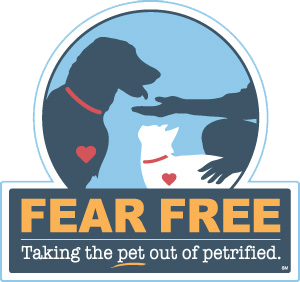Dental Care
Would you believe that the most common disease seen by veterinarians is dental disease? Almost 80 percent of dogs and cats develop periodontal disease by 5 years of age. Periodontal disease is the infection of the tissues that surround the teeth, resulting in the breakdown of the attachments of the teeth to the sockets.

The symptoms of periodontal disease include bad breath, swollen, red, tender gums and an accumulation of tartar on the teeth. In the more advanced stages, the gums may recede, bleed, and become painful. More tartar develops that traps pus beneath the gum line. As the abscess deepens, the teeth loosen in their sockets. Although we tend to think of periodontal disease as an oral problem, the whole body quickly becomes affected. Bacteria from infected gums gain access to your pet’s blood stream, reaping havoc with the immune system, heart, lungs, liver and kidneys. Tiny micro-abscesses form in these organs causing permanent damage. Blood and urine tests can be used to detect defects in these organs possibly resulting from dental disease.
Once established, periodontal disease cannot be cured. It is only through veterinary intervention under a general anesthetic and post surgical home care that periodontal disease can be controlled.
Your pet’s teeth should be examined by a veterinarian annually. Unless you have managed to keep your pet’s teeth clean, your pet will likely require a dental cleaning and polishing at some point. This procedure is very similar to the cleaning we receive at our dentist except the animals must be under a general anesthetic to do the cleaning properly. Some people are concerned about the requirement of a general anesthetic; fortunately the anesthetics veterinarians use today are very safe and well tolerated by our pets, even the very old ones.

An ultrasonic scaler removes the rock hard tartar from the teeth. Then the technician uses hand scaling instruments to remove the finer particles of tartar below the gum line. Once the teeth are cleaned, they are polished to remove the fine dents in the enamel that are created by the bacteria. Having finished her job the technician hands off the reins to the veterinarian to examine the teeth. Each tooth and gum area is carefully examined for inflammation, gingival pockets, decay, loosening and infection. Full mouth digital dental x-rays are taken so that the roots of the teeth and the bones that hold them in place can be examined. Between the examination and the x-rays, the veterinarian can make a comprehensive judgement about the health of the mouth and develop a treatment plan. Devitalized teeth are extracted using elevators and sometimes the high speed dental drill.

Most pets go home the same day, often within a few hours of the dental procedure. To encourage you to brush your pet’s teeth in the future, we will give you a tooth brush, sample of pet tooth paste and home care instructions.
Once your pet has recovered from the dentistry, usually within a few days, your job begins. Preventing the build up of plaque, tartar, and the development of gingivitis again requires a daily effort. Brushing your pet’s teeth is the best way to keep them clean. Unfortunately, not all of our furry friends will cooperate with this harmless procedure. For those pets, we rely on products like dental diets, special chews like C.E.T. dental chews, and Maxiguard oral cleansing gel to help us out. As part of our commitment to your pet’s oral health, we would be happy to help you begin a simple prevention program.








